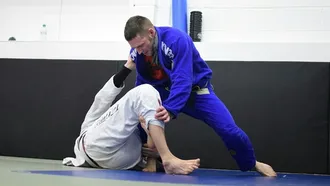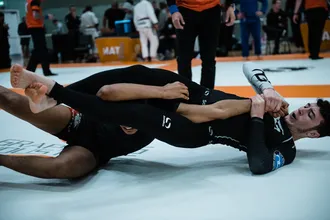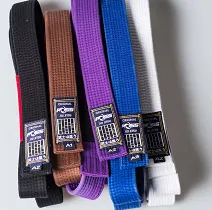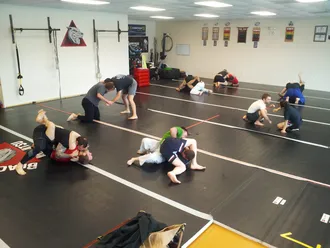Journey to Earning a Blue Belt: How Long To Get a Blue Belt in BJJ

Be patient, have fun, learn the basics. Enjoy the journey. Don’t be in a rush to get your blue belt, to get your first stripe, to get your purple belt. It’s going to come, but you have to be patient.
If you've ever wondered, "How long does it take to get a blue belt in BJJ?", then you're on the right page. This article aims to provide an in-depth analysis of this query, and to offer compelling reasons to inspire you to either commence or continue your journey in Brazilian Jiu Jitsu.
The jiu jitsu blue belt is the first significant promotion and second belt in the BJJ belt system, followed by purple belt, brown belt and black belt, and most practitioners quit before even reaching this stage.
Unlike many other martial arts where belts can be earned quickly, BJJ demands years of dedicated practice, consistent training and proficiency in live sparring.
Each belt level represents a significant achievement, reflecting a practitioner's deep understanding and practical application of techniques.
This rigorous process ensures that BJJ belts are a true testament to a practitioner's skill and dedication, making them highly respected in the martial art community.
The BJJ Blue Belt Journey: A Timeframe
As a general rule, it typically takes anything from 1-3 years of regular training to achieve a blue belt in BJJ.
However, keep in mind that this timeframe is not set in stone. The duration depends on various factors, including the frequency of BJJ training sessions, personal aptitude, determination, and the grading standards of your specific bjj academy or instructor.
Although the conditions and skill level for blue belt can vary widely, for someone attending classes 2-3 times per week consistently, it's reasonable to expect a blue belt promotion within this timeframe.
However, if your goal is to fast-track your progress, attending classes more frequently, going to open mats or taking private lessons can potentially reduce this time.
Factors That Influence Your Journey to a Blue Belt
While understanding the approximate timeframe, it's essential to remember that the journey to a blue belt in BJJ isn't just about the hours spent on the mat.
Proficiency in techniques, understanding of BJJ principles, training frequency and demonstration of effective application during sparring are equally important.
Having success in local competitions, a background in wrestling, Judo or other traditional martial arts can be factor in a faster promotion to blue belt level.
Consistency is Key
Regular and consistent training is fundamental to progression in BJJ.
Consistent practice helps you grasp techniques, understand the flow of movements, and refine your skills.
Moreover, it significantly contributes to enhancing your physical conditioning, a crucial factor in BJJ.
Mindset and Dedication
Possessing the right mindset is integral to your BJJ journey.
Dedication to learning, resilience in the face of challenges, setbacks and the ability to maintain discipline play a significant role in your progression rate.
Setbacks
Life happens. Maybe you move, start a family, become injured. Whatever the reason you will experience setbacks and spend time away from the mats.
When this happens at whatever belt color, promotion to the next level will naturally be delayed.
Key Techniques for a Blue Belt in BJJ
If you're aiming for your blue belt in Brazilian Jiu-Jitsu, there are some essential techniques you'll need to have down pat. Let's break them down:
Fundamental Escapes
First up, you need to master some fundamental escapes. The shrimp, also known as the hip escape, is a core movement that helps you create space and reposition yourself.
The bridge and roll is another crucial escape, particularly useful when you're stuck in someone's mount.
Side control escapes are also a necessity:
If you're in a room full of white belts, and some of those white belts are pinning you down and holding you down as long as they want - you're not ready for blue belt.
Guard Passes and Guard Retention
Next, let’s talk about guard passes. You’ll want to be confident with passing, for example the knee slide pass, a reliable way to cut through an opponent’s guard. The toreando pass is another essential, where you maneuver around the legs rather than through them, adding some dynamic movement to your game.
Similarly with guard retention, you should have somewhat of an guard game and passing your guard should not be without effort and skill from your training partners.
Be familiar with closed guard and half guard concepts.
Sweeps
Sweeps are vital for turning the tables from your guard. The scissor sweep and the hip bump sweep are fundamental techniques that every white belt should have in their arsenal. These moves help you flip the script and end up on top.
Submissions
Of course, you can't forget about submissions. A solid blue belt should be able to execute an armbar, a triangle choke, and a rear-naked choke with confidence. These are some of the most effective and versatile submissions in BJJ.
Positional Control and Transitions
Lastly, positional control and transitions are key. You need to know how to take the fight to the ground, for example with a double leg takedown or a well executed foot sweep.
You are also expected to be able maintain dominant positions like the mount and execute smooth back takes.
Being able to control these positions ensures you can capitalize on your sweeps and submissions.
Overall, reaching blue belt means having a balanced mix of offensive and defensive skills, giving you a strong foundation to build on as you progress in your martial arts journey.
The Value of a Blue Belt
Achieving a blue belt is a significant milestone in BJJ.
It signifies that the student has a solid understanding of the fundamental techniques and can defend themselves using BJJ principles.
Moreover, it represents the shift from being a beginner to transitioning into an intermediate practitioner.
It's a testament to your dedication and hard work, making it a rewarding goal to strive for.
Why Pursue a Blue Belt in BJJ?
BJJ is not just about physical combat—it's about building character, developing discipline, increasing mental fortitude, and enhancing problem-solving skills.
The journey to a blue belt offers you a chance to develop these traits.
Additionally, training BJJ is a remarkable way to improve physical fitness. It enhances your strength, flexibility, and cardiovascular endurance.
So, while you're working towards your blue belt, you're also working towards a healthier you.
Conclusion: Start or Continue Your BJJ Journey Today
Whether you're considering starting BJJ or wondering if you should continue, remember that the journey to a blue belt is one filled with personal growth and physical improvement.
The time invested in earning a blue belt is not merely about the achievement but about the skills, lessons, and benefits you gain along the way.
So step onto the mat, roll, learn, and work your way to that coveted blue belt.
You'll thank yourself later.









